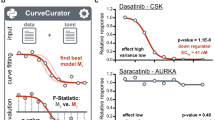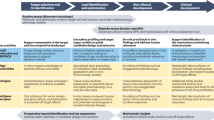Abstract
A key part of drug discovery and development is the characterization and optimization of the safety and efficacy of drug candidates to identify those that have an appropriately balanced safety–efficacy profile for a given indication. The therapeutic index (TI) — which is typically considered as the ratio of the highest exposure to the drug that results in no toxicity to the exposure that produces the desired efficacy — is an important parameter in efforts to achieve this balance. Various types of safety and efficacy data are generated in vitro and in vivo (in animals and in humans), and these data can be used to predict the clinical TI of a drug candidate at an early stage. However, approaches to systematically and quantitatively compare these types of data and to apply this knowledge more effectively are needed. This article critically discusses the various aspects of TI determination and interpretation in drug development for both small molecule drugs and biotherapeutics.
This is a preview of subscription content, access via your institution
Access options
Subscribe to this journal
Receive 12 print issues and online access
$209.00 per year
only $17.42 per issue
Buy this article
- Purchase on Springer Link
- Instant access to full article PDF
Prices may be subject to local taxes which are calculated during checkout


Similar content being viewed by others
References
Paul, S. M. et al. How to improve R&D productivity: the pharmaceutical industry's grand challenge. Nature Rev. Drug Discov. 9, 203–214 (2010).
Ray, A. Beyond debacle and debate: developing solutions in drug safety. Nature Rev. Drug Discov. 8, 775–779 (2009).
Kesselheim, A. S. & Avorn, J. The role of litigation in defining drug risks. JAMA 297, 308–311 (2007).
Kesselheim, A. S. Permitting product liability litigation for FDA-approved drugs and devices promotes patient safety. Clin. Pharmacol. Ther. 87, 645–647 (2010).
Watkins, P. B. Drug safety sciences and the bottleneck in drug development. Clin. Pharmacol. Ther. 89, 788–790 (2011).
Dearden, J. C. In silico prediction of drug toxicity. J. Comput. Aided Mol. Des. 17, 119–127 (2003).
Przybylak, K. R. & Cronin, M. T. In silico models for drug-induced liver injury — current status. Expert Opin. Drug Metab. Toxicol. 8, 201–217 (2012).
Cui, Y. & Paules, R. S. Use of transcriptomics in understanding mechanisms of drug-induced toxicity. Pharmacogenomics 11, 573–585 (2010).
Ge, F. & He, Q. Y. Genomic and proteomic approaches for predicting toxicity and adverse drug reactions. Expert Opin. Drug Metab. Toxicol. 5, 29–37 (2009).
Van Summeren, A., Renes, J., van Delft, J. H., Kleinjans, J. C. & Mariman, E. C. Proteomics in the search for mechanisms and biomarkers of drug-induced hepatotoxicity. Toxicol. in Vitro 26, 373–385 (2012).
Muller, P. Y. & Dieterle, F. Tissue-specific, non-invasive toxicity biomarkers: translation from preclinical safety assessment to clinical safety monitoring. Expert Opin. Drug Metab. Toxicol. 5, 1023–1038 (2009).
Finkel, R, Clark, M. A., Champe, P. C. & Cubeddu, L. X. (eds) Lippincott's Illustrated Reviews: Pharmacology 4th edn (Lippincott Williams & Wilkins, 2008).
Smith, D. A., Di, L. & Kerns, E. H. The effect of plasma protein binding on in vivo efficacy: misconceptions in drug discovery. Nature Rev. Drug Discov. 9, 929–939 (2010).
Lewis, R. W. et al. Recognition of adverse and nonadverse effects in toxicity studies. Toxicol. Pathol. 30, 66–74 (2002).
Lee, C. H. et al. α4β2 neuronal nicotinic receptor positive allosteric modulation: an approach for improving the therapeutic index of α4β2 nAChR agonists in pain. Biochem. Pharmacol. 82, 959–966 (2011).
Muller, P. Y., Milton, M., Lloyd, P., Sims, J. & Brennan, F. R. The minimum anticipated biological effect level (MABEL) for selection of first human dose in clinical trials with monoclonal antibodies. Curr. Opin. Biotechnol. 20, 722–729 (2009).
Toutain, P. L. & Lefèbvre, H. P. Pharmacokinetics and pharmacokinetic/pharmacodynamic relationships for angiotensin-converting enzyme inhibitors. J. Vet. Pharmacol. Ther. 27, 515–525 (2004).
Solon, E. G., Schweitzer, A., Stoeckli, M. & Prideaux, B. Autoradiography, MALDI-MS, and SIMS-MS imaging in pharmaceutical discovery and development. AAPS. J. 12, 11–26 (2010).
International Conference on Harmonisation (ICH). ICH Harmonised Tripartite Guideline: Detection of Toxicity to Reproduction for Medicinal Products & Toxicity To Male Fertility S5(R2). ICH[online], (2005).
International Conference on Harmonisation (ICH). ICH Harmonised Tripartite Guideline: Testing for Carcinogenicity of Pharmaceuticals S1B. ICH[online], (1997).
International Conference on Harmonisation (ICH). ICH Harmonised Tripartite Guideline: Nonclinical Safety Studies for the Conduct of Human Clinical Trials and Marketing Authorization for Pharmaceuticals M3(R2). ICH[online], (2009).
US Department of Health and Human Services, Food and Drug Administration (FDA), Center for Drug Evaluation and Research (CDER). Guidance for Industry: Safety Testing of Drug Metabolites. FDA[online], (2008).
Redfern, W. S. et al. Relationships between preclinical cardiac electrophysiology, clinical QT interval prolongation and torsade de pointes for a broad range of drugs: evidence for a provisional safety margin in drug development. Cardiovasc. Res. 58, 32–45 (2003).
International Conference on Harmonisation (ICH). ICH Harmonised Tripartite Guideline: Non-Clinical Evaluation of the Potential for Delayed Ventricular Repolarization (QT Interval Prolongation) by Human Pharmaceuticals S7B. ICH[online], (2005).
Harmer, A., Valentin, J. P. & Pollard, C. On the relationship between block of the cardiac Na+ channel and drug-induced prolongation of the QRS complex. Br. J. Pharmacol. 164, 260–273 (2011).
US Department of Health and Human Services, Food and Drug Administration (FDA), Center for Drug Evaluation and Research (CDER). Guidance for Industry: Drug Interaction Studies — Study Design, Data Analysis, and Implications for Dosing and Labeling. FDA[online], (2012).
European Medicines Agency (EMA). Guideline on the Investigation of Drug Interactions. EMA[online], (2012).
Cordes, J. et al. Translation between in vitro inhibition of the cardiac Nav1.5 channel and pre-clinical and clinical QRS widening. J. Pharmacol. Toxicol. Methods 60, 221 (2009).
Whitebread, S., Hamon, J., Bojanic, D. & Urban, L. Keynote review: in vitro safety pharmacology profiling: an essential tool for successful drug development. Drug Discov. Today 10, 1421–1433 (2005).
Lounkine, E. et al. Large-scale prediction and testing of drug activity on side-effect targets. Nature 486, 361–367 (2012).
Muller, P. Y. & Brennan, F. R. Safety assessment and dose selection for first-in-human clinical trials with immunomodulatory monoclonal antibodies. Clin. Pharmacol. Ther. 85, 247–258 (2009).
Shankar, G., Pendley, C. & Stein, K. E. A risk-based bioanalytical strategy for the assessment of antibody immune responses against biological drugs. Nature Biotechnol. 25, 555–561 (2007).
Eskens, F. A. & Verweij, J. The clinical toxicity profile of vascular endothelial growth factor (VEGF) and vascular endothelial growth factor receptor (VEGFR) targeting angiogenesis inhibitors; a review. Eur. J. Cancer 42, 3127–3139 (2006).
Freyhaus, H. et al. Imatinib mesylate for the treatment of pulmonary arterial hypertension. Expert Opin. Investig. Drugs. 21, 119–134 (2012).
US Department of Health and Human Services, Food and Drug Administration (FDA), Center for Drug Evaluation and Research (CDER). Guidance for Industry: Bioavailability and Bioequivalence Sudies for Orally Administered Drug products — General Considerations. FDA[online], (2003).
US Department of Health and Human Services, Food and Drug Administration (FDA), Center for Drug Evaluation and Research (CDER). Guidance for Industry: Estimating the Maximum Safe Starting Dose in Initial Clinical Trials for Therapeutics in Adult Healthy Volunteers. FDA[online], (2005).
Muller, P. Y. Comparative requirements for exploratory clinical trials — eIND, eCTA and microdosing. Adv. Drug Deliv. Rev. 63, 511–517 (2011).
Smith, D. A., Morgan, P., Vogel, W. M. & Walker, D. K. The use of Cav rather than AUC in safety assessment. Regul. Toxicol. Pharmacol. 57, 70–73 (2010).
Bender, A. et al. Analysis of pharmacology data and the prediction of adverse drug reactions and off-target effects from chemical structure. ChemMedChem. 2, 861–873 (2007).
Park, B. K. et al. Managing the challenge of chemically reactive metabolites in drug development. Nature Rev. Drug Discov. 10, 292–306 (2011).
Hamon, J. et al. In vitro safety pharmacology profiling: what else beyond hERG? Future Med. Chem. 1, 645–665 (2009).
Fuchs, H., Tillement, J. P., Urien, S., Greischel, A. & Roth, W. Concentration-dependent plasma protein binding of the novel dipeptidyl peptidase 4 inhibitor BI 1356 due to saturable binding to its target in plasma of mice, rats and humans. J. Pharm. Pharmacol. 61, 55–62 (2009).
Wu-Wong, J. R., Dixon, D. B., Chiou, W. J. & Opgenorth, T. J. Endothelin receptor antagonists: effect of serum albumin on potency and comparison of pharmacological characteristics. J. Pharmacol. Exp. Ther. 281, 791–798 (1997).
Schnitzer, J. E. & Oh, P. Albondin-mediated capillary permeability to albumin. Differential role of receptors in endothelial transcytosis and endocytosis of native and modified albumins. J. Biol. Chem. 269, 6072–6082 (1994).
Neumann, E. et al. Native albumin for targeted drug delivery. Expert Opin. Drug Deliv. 7, 915–925 (2010).
US Food and Drug Administration (FDA). Public Health Advisory — Pergolide (marketed as Permax). FDA[online], (2007).
Kvernmo, T., Härtter, S. & Burger, E. A review of the receptor-binding and pharmacokinetic properties of dopamine agonists. Clin. Ther. 28, 1065–1078 (2006).
Thalamas, C. et al. Pergolide: multiple-dose pharmacokinetics in patients with mild to moderate Parkinson disease. Clin. Neuropharmacol. 28, 120–125 (2005).
Mano, Y., Usui, T. & Kamimura, H. Effects of bosentan, an endothelin receptor antagonist, on bile salt export pump and multidrug resistance-associated protein 2. Biopharm. Drug Dispos. 28, 13–18 (2007).
Clozel, M. et al. Pharmacological characterization of bosentan, a new potent orally active nonpeptide endothelin receptor antagonist. J. Pharmacol. Exp. Ther. 270, 228–235 (1994).
Dawson, S., Stahl, S., Paul, N., Barber, J. & Kenna, J. G. In vitro inhibition of the bile salt export pump correlates with risk of cholestatic drug-induced liver injury in humans. Drug Metab. Dispos. 40, 130–138 (2012).
European Medicines Agency (EMA). EMA Summary of Product Characteristics: Tracleer. EMA[online], (2012).
International Transporter Consortium. Membrane transporters in drug development. Nature Rev. Drug Discov. 9, 215–236 (2010).
US Food and Drug Administration (FDA). Drug Approval Package on Bextra (Valdecoxib) Tablets. Company: G.D. Searle & Co. Application No.: 21–341 Approval Date: 11/16/01. FDA[online], (2002).
Dajani, E. Z. & Islam, K. Cardiovascular and gastrointestinal toxicity of selective cyclo-oxygenase-2 inhibitors in man. J. Physiol. Pharmacol. 59 (Suppl. 2), 117–133 (2008).
Acknowledgements
The authors would like to thank B. Schmouder, L. Urban, P. Bouchard, P. Hoffmann, P. Heining and V. Jarugula for their valuable input and in-depth interdisciplinary discussions on this topic.
Author information
Authors and Affiliations
Corresponding author
Ethics declarations
Competing interests
The authors declare no competing financial interests.
Supplementary information
Supplementary information S1 (table)
To convert umol/L to ng/mL: multiply umol/L value by MW of compound. (XLSX 50 kb)
Rights and permissions
About this article
Cite this article
Muller, P., Milton, M. The determination and interpretation of the therapeutic index in drug development. Nat Rev Drug Discov 11, 751–761 (2012). https://doi.org/10.1038/nrd3801
Published:
Issue Date:
DOI: https://doi.org/10.1038/nrd3801
This article is cited by
-
A scoping review on efficacy and safety of medicinal plants used for the treatment of diarrhea in sub-Saharan Africa
Tropical Medicine and Health (2024)
-
Alkyl deoxyglycoside-polymyxin combinations against critical priority carbapenem-resistant gram-negative bacteria
Scientific Reports (2024)
-
Strategies to reduce the risks of mRNA drug and vaccine toxicity
Nature Reviews Drug Discovery (2024)
-
The evolving role of investigative toxicology in the pharmaceutical industry
Nature Reviews Drug Discovery (2023)
-
Preclinical evaluation of bozepinib in bladder cancer cell lines: modulation of the NPP1 enzyme
Purinergic Signalling (2023)



